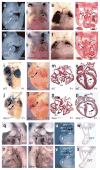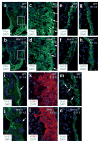Modulation of morphogenesis by noncanonical Wnt signaling requires ATF/CREB family-mediated transcriptional activation of TGFbeta2
- PMID: 17767158
- PMCID: PMC5578467
- DOI: 10.1038/ng2112
Modulation of morphogenesis by noncanonical Wnt signaling requires ATF/CREB family-mediated transcriptional activation of TGFbeta2
Abstract
Transcriptional readout downstream of canonical Wnt signaling is known to be mediated by beta-catenin activation of well-described targets, but potential transcriptional readout in response to noncanonical Wnt signaling remains poorly understood. Here, we define a transcriptional pathway important in noncanonical Wnt signaling. We have found that Wnt11 is a direct target of a canonical beta-catenin pathway in developing heart and that Wnt11 mutants show cardiac outflow tract defects. We provide genetic and biochemical evidence thatWnt11 signaling affects extracellular matrix composition, cytoskeletal rearrangements and polarized cell movement required for morphogenesis of the cardiac outflow tract. Notably, transforming growth factor beta2 (TGFbeta2), a key effector of organ morphogenesis, is regulated by Wnt11-mediated noncanonical signaling in developing heart and somites via one or more activating transcription factor (ATF)/cyclic AMP response element binding protein (CREB) family members. Thus, we propose that transcriptional readout mediated at least in part by a Wnt11 --> ATF/CREB --> TGFbeta2 pathway is critical in regulating morphogenesis in response to noncanonical Wnt signaling.
Figures






Similar articles
-
WNT signaling in adult cardiac hypertrophy and remodeling: lessons learned from cardiac development.Circ Res. 2010 Nov 12;107(10):1198-208. doi: 10.1161/CIRCRESAHA.110.223768. Circ Res. 2010. PMID: 21071717
-
Wnt5a and Wnt11 inhibit the canonical Wnt pathway and promote cardiac progenitor development via the Caspase-dependent degradation of AKT.Dev Biol. 2015 Feb 1;398(1):80-96. doi: 10.1016/j.ydbio.2014.11.015. Epub 2014 Dec 5. Dev Biol. 2015. PMID: 25482987
-
WNT5a is required for normal ovarian follicle development and antagonizes gonadotropin responsiveness in granulosa cells by suppressing canonical WNT signaling.FASEB J. 2016 Apr;30(4):1534-47. doi: 10.1096/fj.15-280313. Epub 2015 Dec 14. FASEB J. 2016. PMID: 26667040 Free PMC article.
-
Noncanonical Wnt signaling in vertebrate development, stem cells, and diseases.Birth Defects Res C Embryo Today. 2010 Dec;90(4):243-56. doi: 10.1002/bdrc.20195. Birth Defects Res C Embryo Today. 2010. PMID: 21181886 Review.
-
Ror-family receptor tyrosine kinases in noncanonical Wnt signaling: their implications in developmental morphogenesis and human diseases.Dev Dyn. 2010 Jan;239(1):1-15. doi: 10.1002/dvdy.21991. Dev Dyn. 2010. PMID: 19530173 Review.
Cited by
-
Human embryonic stem cell-derived cardiomyocytes migrate in response to gradients of fibronectin and Wnt5a.Stem Cells Dev. 2013 Aug 15;22(16):2315-25. doi: 10.1089/scd.2012.0586. Epub 2013 May 8. Stem Cells Dev. 2013. PMID: 23517131 Free PMC article.
-
Inhibition of fibroblast growth by Notch1 signaling is mediated by induction of Wnt11-dependent WISP-1.PLoS One. 2012;7(6):e38811. doi: 10.1371/journal.pone.0038811. Epub 2012 Jun 8. PLoS One. 2012. PMID: 22715413 Free PMC article.
-
Tissue inhibitor of metalloproteinase 2 inhibits activation of the β-catenin signaling in melanoma cells.Cell Cycle. 2015;14(11):1666-74. doi: 10.1080/15384101.2015.1030557. Cell Cycle. 2015. PMID: 25839957 Free PMC article.
-
Myocardial regeneration of the failing heart.Heart Fail Rev. 2013 Nov;18(6):815-33. doi: 10.1007/s10741-012-9348-5. Heart Fail Rev. 2013. PMID: 23001638 Review.
-
Gene-environment regulatory circuits of right ventricular pathology in tetralogy of fallot.J Mol Med (Berl). 2019 Dec;97(12):1711-1722. doi: 10.1007/s00109-019-01857-y. Epub 2019 Dec 13. J Mol Med (Berl). 2019. PMID: 31834445 Free PMC article.
References
-
- Veeman MT, Axelrod JD, Moon RT. A second canon. Functions and mechanisms of β-catenin-independent Wnt signaling. Dev Cell. 2003;5:367–377. - PubMed
-
- Henderson DJ, et al. Cardiovascular defects associated with abnormalities in midline development in the Loop-tail mouse mutant. Circ Res. 2001;89:6–12. - PubMed
-
- Phillips HM, Murdoch JN, Chaudhry B, Copp AJ, Henderson DJ. Vangl2 acts via RhoA signaling to regulate polarized cell movements during development of the proximal outflow tract. Circ Res. 2005;96:292–299. - PubMed
-
- Moon RT. Wnt/β-catenin pathway. Sci STKE. 2005;2005:cm1. - PubMed
-
- Chien KR. Myocyte survival pathways and cardiomyopathy: implications for trastuzumab cardiotoxicity. Semin Oncol. 2000;27:9–14. - PubMed
Publication types
MeSH terms
Substances
Associated data
- Actions
- Actions
- Actions
- Actions
Grants and funding
- HL66276/HL/NHLBI NIH HHS/United States
- R37 DK054364/DK/NIDDK NIH HHS/United States
- R01 DK054364/DK/NIDDK NIH HHS/United States
- DK 064744/DK/NIDDK NIH HHS/United States
- HL65445/HL/NHLBI NIH HHS/United States
- R01 HL065445/HL/NHLBI NIH HHS/United States
- DK18477/DK/NIDDK NIH HHS/United States
- R01 HL074066/HL/NHLBI NIH HHS/United States
- DP1 OD006428/OD/NIH HHS/United States
- HL74066/HL/NHLBI NIH HHS/United States
- R01 DK018477/DK/NIDDK NIH HHS/United States
- R01 HL070867/HL/NHLBI NIH HHS/United States
- HL70867/HL/NHLBI NIH HHS/United States
- R01 NS073159/NS/NINDS NIH HHS/United States
- K01 DK064744/DK/NIDDK NIH HHS/United States
- DK054364/DK/NIDDK NIH HHS/United States
- R01 HL066276/HL/NHLBI NIH HHS/United States
- DP1 HL117649/HL/NHLBI NIH HHS/United States
LinkOut - more resources
Full Text Sources
Other Literature Sources
Molecular Biology Databases

